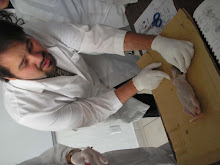Cells, as seen last unit, are what the living organisms are composed of. No living organism does not have cells, and neither does a non-living needs them.
Cells are ''Structural, functional unit of all living organisms'' by definition.
There are two different types of cells, Prokaryotes and Eukaryotes.
There are several differences between them. Prokaryotes are the older, and also the most ancient type of cells. Most compose the numerous bacteria that live even up to this day. Despite their long time of existence, they haven't changed much of their simple structure. They don't have a nucleous, and neither the endomembrane system. The genetic information withing them float free in the citoplams. As for movement, they only have the flagellum.
Meanwhile, Eukaryotes are more recent. They, unlike the former ones, do have a nucleous, and also compose the multicellular organisms, while Prokaryotes come in only unicellular life forms.
Then we saw about Bacteria. Bacteria are prokaryotes that can be found nearly anywhere, even in the human body. Bacteria are responsible for diseases called infections, and the only way to kill them off is by te use of antibiotics. These only work on bacteria, and nothing else, though it's also possible for the bacteria to develop a resistance to it, which is why it's unadvisable to use them if they aren't needed.
The bacteria usually infect by injecting toxins to the cell, or just touching them with their membrane, which can also carry the toxins.
Yet, just are there are bad bacteria for the humans, there are also harmless, and even benefical ones. Some harmless bacteria even right now live in the skin, though that's just it, nothing more or less. Yet, this can be helpful since if a bacteria, probably a harmful one, arrives, and the bacteria will repell it as it would be intruding it's home.
Then, bacteria are also responsible for the creating of some consumables, like bread, milk-related products, and alcohol.
Finally, we saw about the Archaeobacteria. These ones are noticable in being able to live through extreme conditions. Some would be the Thermoacidophiles, who live in extremly hot and acid places, like in the ocean floor where the magma from the mantle travels out into the water.
Then there are the Halophiles, who live in very salty places, and are in fact the only living organisms capable of living in the Dead Sea.
Finally, there are the Methonagen, who live in places with a lack of oxygen, like swamps, where even other organisms living there have to get out of it in order to breath from now and then, yet these bacteria don't need to.
Juan Manuel Aguirre G.

for the ancient life forms we can also called them "Archaobacteria"
ResponderEliminar